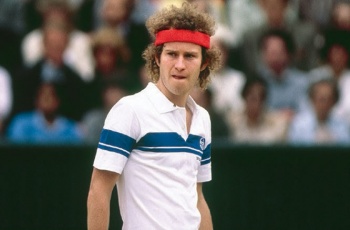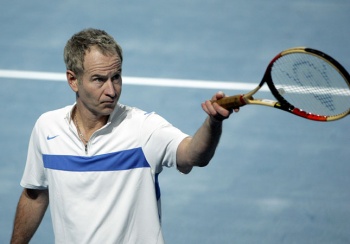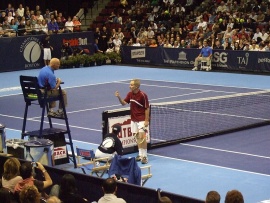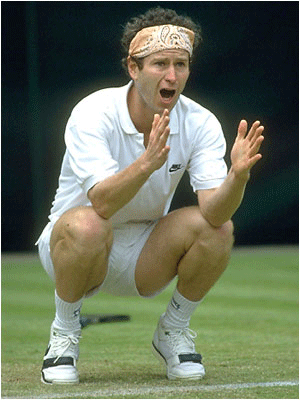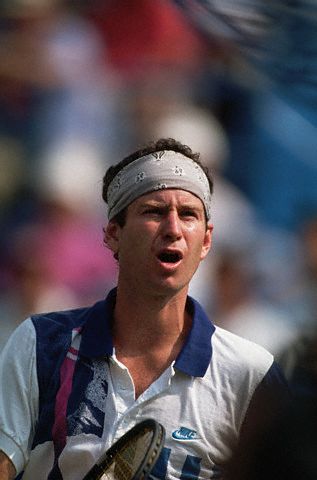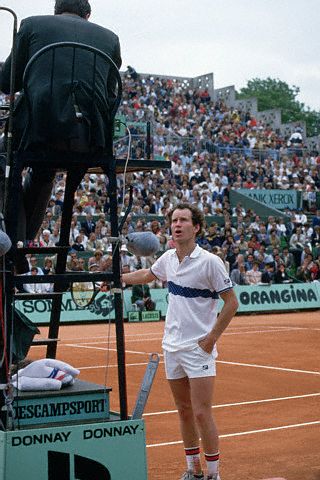John McEnroe
Fu anche un esperto giocatore di doppio e terminò la carriera con 77 vittorie nei tornei di singolo e 78 in quelli di doppio. McEnroe fu un membro fisso della squadra statunitense di Coppa Davis, squadra che ha anche diretto, dopo il suo ritiro dal tennis giocato.
Ha ottenuto le seguenti vittorie nei tornei del Grande Slam:
Indice
Biografia
Nato in una base militare statunitense nell'ex-Germania Ovest, crebbe però nel Queens (New York). McEnroe esplose sulla scena del tennis internazionale nel 1977, a soli diciott'anni, quando, partendo dalle qualificazioni, raggiunse le semifinali del Torneo di Wimbledon. Frequentò la Stanford University, e vinse il titolo NCAA del singolare maschile nel 1978. McEnroe divenne famoso anche per il suo temperamento volubile e le sue memorabili discussioni con i giudici di sedia, che resero famosa la sua frase "You cannot be serious" ("Non stai dicendo sul serio"), che in seguito divenne il titolo della sua autobiografia. Inizialmente fischiato dal pubblico, soprattutto in Inghilterra, ne vinse pian piano l'apprezzamento. Nel 2001, John McEnroe visitò Buckingham Palace su invito della regina Elisabetta II. Nel 2002, McEnroe pubblicò la suddetta autobiografia. Per oltre un decennio, John McEnroe è stato un ottimo commentatore degli incontri di tennis e telecronista per NBC e CBS negli USA e per la BBC nel Regno Unito. Vive con la moglie, Patty Smyth, e con sei figli (tre dal primo matrimonio con Tatum O'Neal, 2 avuti dalla Smyth, e uno avuto dall'attuale moglie con il precedente marito).
A febbraio 2006, all'età di 47 anni, è tornato a giocare a livello professionistico (ATP) nel torneo di doppio SAP Open a San Josè (California) in coppia con Jonas Bjorkman; la coppia si è aggiudicata il torneo. McEnroe ha così dimostrato, vincendo il suo titolo numero 78 in doppio, che la sua classe non ha età; è diventato così l'unico uomo a vincere un torneo ATP in 4 decadi differenti.
Il tennis
La rivoluzione apportata da McEnroe al tennis non ha precedenti. Per ammissione dello stesso Jimmy Connors, nessuno ha creato tanto interesse attorno al tennis quanto John McEnroe. In parte grazie al suo carattere irascibile e alle celebri sfuriate contro arbitri, avversari, e giudici di linea. Ma soprattutto grazie al suo gioco personalissimo e micidiale.
McEnroe ha dominato il mondo del tennis prima e dopo la principale svolta nell'evoluzione dei materiali, dal legno (quando usava una Dunlop MaxPly) alla grafite (quando sfoggiava la sua leggendaria Dunlop Max 200G). La sua grande capacità di controllo gli consentiva una incordatura a soli 18 kg., che esaltava la sua grande sensibilità di tocco.
McEnroe, mancino, era un giocatore d'attacco, che faceva del serve-and-volley, delle risposte d'attacco, e del gioco anticipato da fondo le sue armi principali.
Non c'era una parte del gioco di McEnroe che non fosse giustamente famosa. A partire dal celeberrimo servizio, che, grazie anche a una grande torsione lombare, era effettuato con i piedi paralleli alla linea di fondo campo e le spalle rivolte alla rete. Erano particolarmente insidiosi i suoi servizi a uscire dalla sinistra del campo. Il suo gioco da fondo consisteva di un diritto piatto, personalissimo, ed un rovescio a volte nascosto, da sotto, a volte "spinto", effettuato con il piatto della racchetta davanti al corpo, soprattutto nella risposta al servizio, quando veniva eseguito a mezz'aria con un balzo in avanti. Il tutto spesso giocato con una sola impugnatura, una vecchia Continentale. Il suo gioco d'attacco da fondo campo era basato sull'uso di colpi anticipati, sostenuti da riflessi incredibili, che lo mettevano in grado di essere sempre un passo avanti all'avversario (il famoso "ping-pong" tennis). Il suo gioco difensivo poteva contare su passanti eccezionali (tra cui il famoso "passante lento" e i suoi passanti giocati al volo, dalla tre quarti campo) e lob millimetrici. Infine, la parte più famosa del suo gioco: le sue volée, spesso piatte, precisissime, che sembravano effettuate con il minimo sforzo, sfruttavano una comprensione innata della balistica. McEnroe disponeva di una varietà di colpi di volo perfetti eseguiti con grande naturalezza (smorzate, demi-volée) e con un tocco che era diventato il suo sigillo.Il bilancio nei tornei del Grande Slam
Titoli del Grande Slam (singolo)
| Anno | Torneo | Avversario in finale | Punteggio della finale |
| 1979 | U.S. Open | Vitas Gerulaitis | 7-5, 6-3, 6-3 |
| 1980 | U.S. Open | Björn Borg | 7-6, 6-1, 6-7, 6-7, 6-4 |
| 1981 | Wimbledon | Björn Borg | 4-6, 7-6, 7-6, 6-4 |
| 1981 | U.S. Open | Björn Borg | 4-6, 6-2, 6-4, 6-3 |
| 1983 | Wimbledon | Chris Lewis | 6-2, 6-2, 6-2 |
| 1984 | Wimbledon | Jimmy Connors | 6-1, 6-1, 6-2 |
| 1984 | U.S. Open | Ivan Lendl | 6-3, 6-4, 6-1 |
Titoli del Grande Slam (doppio maschile)
| Anno | Torneo | Compagno | Punteggio della finale |
| 1979 | Wimbledon | Peter Fleming | 4-6, 6-4, 6-2, 6-2 |
| 1979 | U.S. Open | Peter Fleming | 6-2, 6-2 |
| 1981 | Wimbledon | Peter Fleming | 6-4, 6-4, 6-4 |
| 1981 | U.S. Open | Peter Fleming | ritiro avversari |
| 1983 | Wimbledon | Peter Fleming | 6-4, 6-3, 6-4 |
| 1983 | U.S. Open | Peter Fleming | 6-3, 6-4, 6-2 |
| 1984 | Wimbledon | Peter Fleming | 6-2, 5-7, 6-2, 3-6, 6-3 |
| 1989 | U.S. Open | Mark Woodforde | 6-4, 4-6, 6-3 6-3 |
| 1992 | Wimbledon | Michael Stich | 5-7, 7-6, 3-6, 7-6, 19-17 |
Titoli del Grande Slam (doppio misto)
| Anno | Torneo | Compagna | Punteggio della finale |
| 1977 | Open di Francia | Mary Carillo | 7-6, 6-3 |
I tornei anno per anno
| right=0 0 .5em .5em | left=0 .5em .5em 0 | center=auto | 0 .5em .5em 0}}; margin-top:.5em; margin-bottom:.5em; background:#FAFAFA; border:1px #CCC solid; border-collapse:collapse; text-align:{{{text-align}}}; font-family: Arial Unicode MS, Lucida Sans Unicode, Lucida Grande, TITUS Cyberit Basic, Code2000, MV Boli, @MS Mincho"" | |||||||||||||
| Torneo Grande Slam | 1977 | 1978 | 1979 | 1980 | 1981 | 1982 | 1983 | 1984 | 1985 | 1986 | 1987 | 1988 | 1989 | 1990 | 1991 | 1992 |
|---|---|---|---|---|---|---|---|---|---|---|---|---|---|---|---|---|
| Australian Open | (-) | - | - | - | - | - | SF | - | QF | - | - | - | QF | OF | - | QF |
| Open di Francia | (2T) | - | - | 3T | QF | - | QF | F | SF | - | 1T | OF | - | - | 1T | 1T |
| Wimbledon | (SF) | 1T | OF | F | V | F | V | V | QF | - | - | 2T | SF | 1T | OF | SF |
| US Open | (OF) | SF | V | V | V | SF | OF | V | F | 1T | QF | 2T | 2T | SF | 3T | OF |
| Tornei vinti | (0) | 6 | 10 | 8 | 10 | 5 | 7 | 13 | 8 | 3 | 0 | 2 | 3 | 1 | 1 | 0 |
| Classifica | (21) | 4 | 3 | 2 | 1 | 1 | 1 | 1 | 2 | 14 | 10 | 11 | 4 | 13 | 28 | 20 |
Le statistiche tra parentesi sono relative al primo anno, quando era ancora dilettante.
OF = Ottavi di finale; QF = Quarti di finale; SF = Semifinale; F = Finale; V = Vittoria nel torneo; 1T-3T = 1.-3. Turno
CAREER HIGHLIGHTS
http://www.atpworldtour.com/Tennis/Players/Mc/J/John-Mcenroe.aspx
Right from the start, in his 1977 introduction to pro tennis, John Patrick McEnroe, Jr., was a hit. An 18-year-old amateur (he would not turn pro until winning the National Intercollegiate singles as a Stanford freshman in 1978), McEnroe made his first splash in Paris, a boy edging into man's territory. He won his first of 17 major titles there, the French mixed with childhood pal, Mary Carillo, over the Romanian-Colombian combine of Florenta Mihai and Ivan Molina. Soon after, electrifying Wimbledon, he went through the qualifying tourney and all the way to the semis, losing to Jimmy Connors. It was a major tourney record for a qualifier (equaled by Belarussian Vladimir Voltchkov in 2000). It was also a record for an amateur in the open era. Immediately Mac was a player to reckon with.
Born Feb. 16, 1959, in Wiesbaden, Germany, where his father was stationed with the U.S. Air Force, he grew up in the Long Island suburb of Douglaston, N.Y. A 5-foot-11, 170-pound left-hander, McEnroe stands as perhaps the most skilled - and controversial - of all players. Brilliant in doubles and singles, he was distinguished by shot making artistry, competitive fire and a volatile temper. The last led to heavy fines, suspensions and, at the 1990 Australian Open, an extraordinary fourth-round disqualification for showering abusive language on court officials. A magnificent volleyer with a feathery touch, he was an attacker whose fast court style netted four U.S. Open and three Wimbledon singles. He had the baselining strength to do well on clay at the French. He might have won that at his zenith, but in the 1984 final he led Ivan Lendl, 2-0 in sets, only to be distracted by temperamental outbursts, and was beaten, 3-6, 2-6, 6-4, 7-5, 7-5.
He revived American interest in the Davis Cup that had been shunned by Connors and other leading countrymen, saying, "My mother made me promise her I'd always play for my country if I was asked." Right from the start, as a 19-year-old rookie in 1978, he gave Capt. Tony Trabert's team a lift, and gave the U.S. the Cup that had belonged to other countries since 1973. In the championship round against Britain at Rancho Mirage, Calif., he showed none of the jitters so common to many other greats making debuts in the nationalistic setting. Mac was a miser, rationing John Lloyd (6-1, 6-2, 6-2) and Buster Mottram (6-2, 6-2, 6-1) to 10 games. Nobody had been stingier in a final. He was the most callow American to do so well in the Cup round, although Lew Hoad, a younger 19 by eight months for victorious Australia, also took both his singles in 1953,and American Michael Chang, 18, won one singles in the winning 1990 final. Aussie Lleyton Hewitt, also older than Hoad at 19, split his singles in the triumphant 2000 final. McEnroe continued as a mainstay in helping the U.S. win four more Cups (1979, '81-'82, '92), and set numerous U.S. records: Years played (12), series (30), singles wins (41), singles and doubles wins altogether (59).
A workhorse, he played both singles and doubles in13 series, and he and Peter Fleming won 14 of 15 Cup doubles together. An epic performance was his record-time six-hour-22minute, five-set victory over Mats Wilander in St. Louis, clinching a 1982 quarter-final, 3-2, win over Sweden. He and German Boris Becker nearly topped that, using six hours, 21 minutes for Boris' 1987 Cup relegation victory at Hartford. Another thriller was Mac's five-set win over Jose-Luis Clerc of Argentina to send the Cup to the U.S. in the 1981 final at Cincinnati. McEnroe was named U.S. captain in 1999 and served one year, 2000, quitting after three series (3-2 wins over Zimbabwe and the Czech Republic, a 5-0 loss to Spain),and was replaced by his younger brother, Patrick McEnroe.
At 20, John won the U.S. title for the first time over fellow New Yorker Vitas Gerulaitis, the youngest winner since Pancho Gonzalez, also 20, 31 years before. He repeated in dramatic battles with Bjorn Borg in 1980 and 1981. Borg retired shortly thereafter. McEnroe won for the last time in 1984, over Lendl. But he was defeated in the Flushing Meadow rematch 12 months later, relinquishing to Lendl the World No. 1 ranking McEnroe had held for four years. His most celebrated result may have been a loss, the 1980 Wimbledon final called by many the greatest of all. Beaten, 1-6, 7-5, 6-3, 6-7 (16-18), 8-6, McEnroe nervelessly staved off five match points during the monumental fourth-set tie-breaker to fight Borg to the fifth-set wire. A year later he cut down Borg on Centre Court, 4-6, 7-6 (7-1), 7-6 (7-4), 6-4, ending Bjorn's incredible five-year, 41-match Wimbledon run. McEnroe won again in 1983, a quickie with unseeded New Zealander Chris Lewis and in 1984, reaching the pinnacle of his virtuosity; a virtually flawless wipeout of Connors, 6-1, 6-2, 6-2.
There were many ups and downs at Wimbledon, where McEnroe came close to being tossed out prior to his initial championship,1981, following a second-round flare up while beating Tom Gullikson. It was the infamous scene of labeling the umpire, Ted James, "pits of the world," and calling the referee every name but Fred Hoyles (which was his name). He went out in grand manner in 1992. Unseeded at No. 30, 33-year-old Mac wound up where he'd begun 15 years before: The semis, on a stirring knockout of ninth-seeded Guy Forget. He'd already beaten 16th-seeded David Wheaton in three, and won a rousing four-hour, nine-minute "battle of champions" over Pat Cash. But champ-to-be Andre Agassi was too much for him in the goodbye singles, 6-4, 6-2, 6-3.
Yet there was more, and Mac's fading presence would be stretched triumphantly over two days and Wimbledon's longest closing act on the third Monday: His fifth doubles title, this time without old collaborator Peter Fleming, but with a stranger who did just fine, Michael Stich. Two points from defeat in the fourth-set-breaker, tied at darkness, 13-13, the German-American combine came through over Richey Renbeberg and Jim Grabb, 5-7, 7-6 (7-5), 3-6, 7-6 (7-5),19-17, a record-length final, five hours, one minute. Eight years had passed since his last title. "It was a great atmosphere [Court 1 was packed with 6,500 Mac fans],a great way to go out," Mac said.
Three intense rivalries stand out during his career. He had the edge on Connors (31-20), but not Lendl (15-21), and was even with Borg (7-7). Except for the French Open lapse against Lendl, he was unbeatable in 1984, winning 13 of 15 singles tournaments on an 82-3 record. Other big seasons were 1979 (10 titles on a 94-12 record), 1980 (10 titles on 88-18). In 1979 he set an open-era record with 27 overall tournament victories, 17 in doubles, winning a record total of 177 matches. He won the season-climaxing Masters singles thrice, 1978, '83-'84, and is the all-time overall Open Era leader with 155 tournament victories: 77 singles and 78 doubles. He is third in singles titles behind Connors's 109 and Lendl's 92, tied second in doubles (with Tom Okker) behind Todd Woodbridge's 83. His career singles W-L record is 849-184. Ten years a member of the World Top 10, he was four times No. 1 (1981-84).
Brother, Patrick McEnroe, younger by seven years (b. July 1, 1966), followed him as a standout pro, winning the French doubles (with Grabb) in 1989, ranking as high as No. 28 in 1995. In 1991 they met in the Chicago final, the second such clash of brothers (Emilio Sanchez defeated Javier Sanchez in the 1987 Madrid final). John won, 3-6, 6-2, 6-4. His prize money for 15 years as a pro was $12,539,827. He has three children by ex-wife Tatum O'Neal, two by wife Patty Smythe, continues to play senior events and has made a successful career as a TV commentator on tennis.
MAJOR TITLES (17) - Wimbledon singles, 1981, 1983, 1984; US. singles, 1979, 1980, 1981, 1984; Wimbledon doubles, 1979, 1981, 1983, 1984, 1992; US. doubles, 1979, 1981, 1983, 1984; French mixed, 1977
OTHER U.S. TITLES (4)-Indoor singles, 1980; Hard Court singles, 1989; Indoor doubles, 1980, with Brian Gottfried; Clay Court doubles, 1979, with Gene Mayer.
DAVIS CUP - 1978, 1979,1980, 1981, 1982, 1983, 1984, 198Z 1988, 1989, 1991, 1992; record 41-8 in singles, 18-2 in doubles.
SINGLES RECORD IN THE MAJORS - Australian (18-5), French (25-10), Wimbledon (59-11), US (65-12).
- Bio Courtesy Bud Collins
McEnroe was McNasty on and off the court
By Larry Schwartz Special to ESPN.com http://espn.go.com/classic/biography/s/McEnroe_John.html
"I wanted to spend [the night] with my family and friends and the people who had supported me, not a bunch of stiffs who were 70-80 years old, telling you that you're acting like a jerk," says John McEnroe on ESPN Classic's SportsCentury series about why he didn't attend the traditional Wimbledon winners dinner in 1981.
John McEnroe won three Wimbledon titles -- 1981, 1983 and 1984.
John McEnroe was a winner and a whiner, a super talent nicknamed Superbrat. A lefthander with all the strokes, he never felt a need to stroke anybody.
A serve-and-volleyer, his shotmaking artistry enabled him to dominate tennis from 1981-84. He dethroned Bjorn Borg at Wimbledon, winning three championships on the prestigious grass courts just outside London. On this side of the Atlantic, he won four U.S. Open titles.
McEnroe finished with $12,539,622 in official earnings and 77 singles titles, third most behind Jimmy Connors' 109 and Ivan Lendl's 94. He won 17 Grand Slam championships, including nine in men's doubles (seven with Peter Fleming) and one in mixed doubles with Mary Carillo at the French Open. His Davis Cup record was 41-8 in singles and 18-2 in doubles as he helped the U.S. win five Cups.
"John can change his tactics and style to adjust to his opponent's strategy and to the court surface," said Arthur Ashe, the 1975 Wimbledon champ who also was one of McEnroe's Davis Cup captains. "He has tremendous hand-eye coordination, and he's quick, with tremendous footwork. Playing soccer probably helped him a lot. What puts it all together is his timing. That's something you're born with, but McEnroe has sharpened his through practice.
"His serve is not the hardest, but he can change speed and angle. He also has the advantage of being lefthanded, which causes his spin serves to break in the opposite direction from righthanders and confuse them."
McEnroe could have been more popular. He played with a competitive fire and a fierce determination, traits that the public adores. But he also constantly argued and put down umpires and linesmen for what he perceived as bad calls.
"I know I can see the ball better than the officials," he said. "I can 'feel' when a ball is out or not. What's so frustrating is to know you're right and not be able to do anything about it."
When he was just 20, he was nicknamed "Superbrat" by the outrageous British tabloids in 1979. "He is the most vain, ill-tempered, petulant loudmouth that the game of tennis has ever know," The Sun wrote.
American journalists were not much kinder to the young McEnroe.
"McEnroe does most of his pouting on the courts," wrote Newsweek's Pete Axthelm. "In private, this devastating athlete can be a nice enough kid . . . but when he steps to the service line, with his perpetually put-upon expression and his insistence that every line call and crowd reaction go his way, his public posture is all too easy to understand. Call it spoiled."
The Washington Post's Barry Lorge: "He came across as a precocious brat -- immensely talented, spoiled and rather obnoxious. On the court, he pouted, cursed, threw his racket. . . . He was a crybaby. Off court, he demonstrated little savoir faire.
"Scoffed one appalled gentleman after encountering a sticky-fingered McEnroe in the players' tearoom: 'The boy wonder is upstairs, eating the traditional strawberries and cream without benefit of the traditional spoon.' "
Even the player's father, John Sr., said, "John sets high standards for himself and doesn't suffer fools gladly. What you might say about John is that he shoots from the hip through his mouth." Through the years, McEnroe never changed. At the 1990 Australian Open, McEnroe was disqualified for using abusive language at court officials. His image remains of someone pouting and cursing, throwing rackets and tantrums.
He was born Feb. 16, 1959 in Wiesbaden, Germany, while his father, now an attorney, served as a U.S. Air Force officer. Before John was a year old, the family moved back to Queens, and eventually settled in Douglas Manor, by the shores of Long Island Sound.
He was shorter than most of his peers and pudgy in his early teens. His game took off after he graduated from Manhattan's Trinity School. In 1977, at the age of 18, he qualified for Wimbledon and became the youngest player and first qualifier to reach the semifinals, where Connors beat him. That fall, he entered Stanford and led the team to the NCAA title while he won the singles championship. Then he turned pro.
In 1979, he won his first U.S. Open, beating Vitas Gerulaitis in straight sets in the final to become the youngest winner of the U.S. championships in 31 years, since Pancho Gonzales, also 20.
His 1980 Wimbledon final against four-time champion Bjorn Borg was a classic. Down two sets to one, and trailing 5-4 in the fourth set, McEnroe broke Borg, and soon it was 6-6. In a tiebreaker for the ages, McEnroe saved five championship points before prevailing, 18-16. McEnroe, though, couldn't break Borg again and lost the fifth set, 8-6. But in 1981, the attacking McEnroe ended Borg's Wimbledon reign at five consecutive championships and 41 straight winning matches when he beat him in the finals in four sets, including two tie-breakers. The date was July 4 and McEnroe was dressed in blue and white with a red headband. "Stick a feather in his cap and call him McEnroney," said sportscaster Bud Collins.
McEnroe leaps into the air after making shot at 1984 Wimbledon.
Of course, the road to the finals was full of confrontations. In his first match, there was his infamous blowup when McEnroe verbally blasted umpire Ted James, calling him "the pits of the world," and then cursed tournament referee Fred Hoyles. He was fined $1,500. The Fleet Street journalists savagely ripped him.
At the U.S. Open that year, McEnroe also beat Borg, the second consecutive year he whipped the gentlemanly Swede in the final. "I felt I could do anything," McEnroe said. Not since Bill Tilden had won six consecutive U.S. titles in the 1920s had a male player won three straight, as McEnroe had.
McEnroe also was the key to the U.S. winning the Davis Cup in 1981 - his five-set win over Argentina's Jose-Luis Clerc was the clincher. He was the first to sweep the singles at Wimbledon, the U.S. title and the Davis Cup final since Don Budge in his Grand Slam year of 1938.
Despite his success, the world's No. 1 player from 1981-84 was offered few endorsement opportunities. "When I see McEnroe, I see 'bad sport,' " said the president of a Madison Avenue ad agency. "I wouldn't want him identified with my product."
In 1982 Davis Cup play, McEnroe defeated Mats Wilander in an epic six-hour-and-22-minute match, with the five-set win giving the U.S. a 3-2 quarterfinal victory over Sweden. McEnroe successfully led the finals' defense against France.
McEnroe just blew away the competition in 1984, compiling an incredible 82-3 record and winning a career-high 13 tournaments, including his third Wimbledon and fourth U.S. Open.
One of the defeats, though, came in the French Open final, when he let a two-set lead slip away and lost in five sets to Lendl. The loss ended McEnroe's 39-match winning streak and was the closest he would ever come to a French Open championship.
Two years later, McEnroe left the ATP tour for 6½ months before coming back to win three titles in the fall. While on sabbatical in 1986 he married actress Tatum O'Neal. They divorced in 1992. McEnroe married musician Patty Smyth in 1997.
In 1987, McEnroe didn't win a title for the first time since turning pro. He took a seven-month break from the game following the U.S. Open, where he was suspended for two months and fined $17,500 for misconduct and verbal abuse.
McEnroe, whose last year on tour was 1992, was named captain of the U.S. Davis Cup team in 1999. On November 20, 2000, he resigned after only 14 months as Davis Cup captain. McEnroe cited his frustration with the Davis Cup schedule and format as two of the primary reasons. He fills his time by playing on the over-35s tour and being a TV color commentator at major tournaments. He still shoots from the hip with his mouth, only now he earns money for doing it instead of dishing it out in fines.

